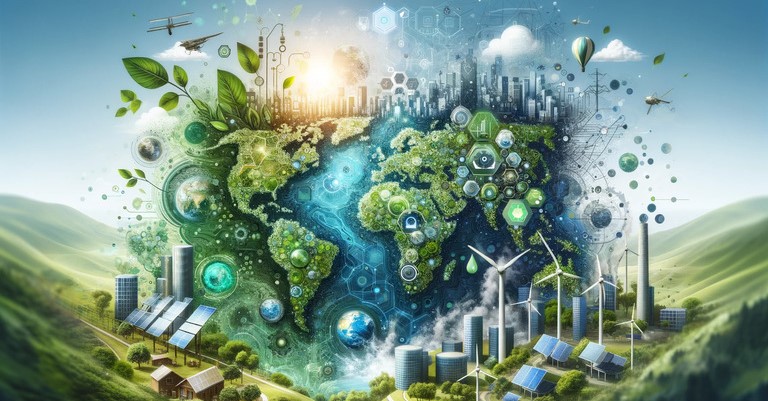In the quest for a greener future, the convergence of Generative AI and sustainable development emerges as a beacon of hope. This fusion represents an innovative pathway to addressing environmental challenges through the lens of advanced technology. Generative AI, with its ability to create, simulate, and optimize, holds untold potential for fostering sustainable practices across various sectors. By leveraging these technologies, we can envision a world where development no longer comes at the expense of our planet.
Generative AI Technology and Sustainability
Generative AI technology stands at the forefront of this revolution, offering groundbreaking solutions for sustainability. It extends beyond traditional applications, pushing the boundaries of innovation to develop AI-driven environmental solutions that are both effective and sustainable. Whether it’s through optimizing renewable energy grids or creating models to predict and mitigate climate change effects, generative AI is redefining what’s possible in the realm of environmental sustainability. Some of the latest quantitative data and figures are provided below:
- 1. Generative AI Market Growth: The generative AI market is expected to grow from $1.5 billion in 2021 to $6.5 billion by 2026, with a compound annual growth rate of 34.9%.
- 2. Environmental Costs: Generative AI systems are increasingly being scrutinized for their environmental impact. It’s estimated that a search driven by generative AI uses four to five times the energy of a conventional web search. In terms of water usage, a data-center cluster serving OpenAI’s GPT-4 used about 6% of the district’s water in West Des Moines, Iowa, in July 2022.
- 3. Generative AI Revenue: In 2024, the revenue from generative AI is projected to be $137 billion.
AI for Sustainability and Environmental Solutions
AI for sustainability focuses on harnessing artificial intelligence to tackle critical environmental issues, from climate change mitigation to renewable energy solutions. AI-driven environmental solutions encompass a broad spectrum of applications, including analyzing vast datasets to identify patterns and predict climate trends, optimizing resource use, and enhancing the efficiency of green technologies. Through these initiatives, AI contributes significantly to advancing the Sustainable Development Goals (SDGs) by offering smarter, more effective ways to protect our planet.
Renewable Energy and Eco-friendly Innovations
Generative AI’s role in renewable energy underscores its capacity to drive eco-friendly innovations. By integrating AI into renewable energy systems, we can enhance their efficiency, reliability, and capacity to meet energy demands sustainably. Machine learning algorithms are pivotal in forecasting energy production from renewable sources, enabling smarter grid management and facilitating the transition to green energy.
Sustainable Development Goals (SDGs) and Green Technology
The Sustainable Development Goals (SDGs) serve as a universal call to action to end poverty, protect the planet, and ensure prosperity for all. Achieving these goals necessitates the adoption of green technology innovations and climate change mitigation strategies. Generative AI contributes to this mission by offering solutions that are not only technologically advanced but also environmentally responsible and sustainable.
AI in Green Technology and Sustainable Agriculture
The application of AI in green technology and sustainable agriculture illustrates the transformative potential of AI for environmental sustainability. Eco-friendly AI applications are making strides in optimizing agricultural practices, reducing waste, and conserving resources. Sustainable AI practices in agriculture include precision farming, which uses AI to monitor crop health and soil conditions, thus ensuring higher yields with minimal environmental impact.
A Deeper Dive into Generative AI and Sustainability
Exploring how generative AI contributes to sustainable development reveals its multifaceted impact. From innovations in renewable energy and sustainability to the role of machine learning in environmental sustainability, the integration of generative AI is pivotal. It not only aids in sustainable urban planning but also plays a crucial role in reducing the carbon footprint of industries. Addressing the challenges of integrating AI in sustainable development requires a balanced approach, focusing on innovation while ensuring environmental integrity.
Future Prospects and Challenges
As we look towards the future of sustainability with generative AI, it’s clear that the potential is vast, yet not without challenges. Questions about the environmental impact of AI itself, the scalability of AI solutions for sustainable resource management, and the real-world implementation of these technologies are critical. Through case studies and ongoing research, the path to a more sustainable and AI-integrated future becomes clearer, marked by continuous learning and adaptation.
Related Technologies and Trends
The synergy between green computing and AI, alongside the development of sustainable AI algorithms and energy-efficient machine learning, highlights the tech community’s commitment to reducing the environmental impact of AI technologies. Innovations such as AI for water conservation and waste management exemplify the practical application of AI in achieving greater sustainability, showcasing a promising trajectory towards a greener, more technologically advanced future.
Harnessing Generative AI for Environmental Monitoring
Generative AI plays a crucial role in processing and analyzing real-time environmental data, enabling more effective monitoring of ecological changes and pollution levels. This capability is essential for early detection of environmental threats and informed decision-making.
By generating predictive models, generative AI assists in forecasting environmental trends and potential disasters. This anticipatory approach allows for proactive measures to protect ecosystems and mitigate the impacts of climate change.
The Intersection of AI and Clean Energy
Generative AI technologies are being used to develop systems that can predict and optimize energy consumption in real time, ensuring energy efficiency and reducing wastage in both residential and industrial settings.
AI-driven research is leading to breakthroughs in energy storage solutions, such as more efficient batteries, which are pivotal for the broader adoption of renewable energy sources like solar and wind power.
AI-Driven Sustainable Urban Development
Generative AI aids in creating sustainable urban designs that optimize land use, enhance green spaces, and minimize environmental footprints. These AI models take into account various factors, including traffic flow, population density, and resource allocation, to design more livable and sustainable cities.
Leveraging AI for waste management revolutionizes recycling processes and waste reduction strategies. AI systems can sort recyclables more efficiently and identify waste reduction opportunities, contributing significantly to sustainable urban ecosystems.
Advancing Sustainable Agriculture with AI
Generative AI enables precision agriculture, which uses data analytics to optimize planting, watering, and harvesting. This technology helps in maximizing yield while minimizing environmental impacts like overuse of water and fertilizers.
AI technologies facilitate the remote monitoring of crop and soil health, allowing for timely interventions to prevent disease spread or nutrient deficiencies. This approach not only increases agricultural productivity but also promotes sustainable farming practices.
Ethical Considerations and Sustainability in AI Development
As the AI sector grows, so does its energy consumption. Addressing the carbon footprint of training large AI models is vital for ensuring that AI development aligns with sustainability goals.
Ensuring that the benefits of AI for sustainability are distributed fairly across different regions and communities is essential. This involves developing AI solutions that are accessible to underserved populations and tailored to local environmental challenges.
The Future of Generative AI in Environmental Advocacy
Generative AI can be used to create immersive simulations and visualizations that highlight environmental issues and the importance of sustainability, thereby raising public awareness and advocacy.
By providing accurate data and predictive insights, AI technologies can support policy-making processes, helping to craft more effective environmental regulations and sustainability standards. Some latest facts and figures for the future of generative AI in environmental advocacy:
- 1. Energy Consumption: Generative AI systems are expected to consume as much energy as entire nations within a few years. A single search driven by generative AI uses four to five times the energy of a conventional web search.
- 2. Water Usage: In West Des Moines, Iowa, a data-center cluster serving OpenAI’s GPT-4 used about 6% of the district’s water in July 2022. Google and Microsoft reported increases of 20% and 34%, respectively, in water use in one year due to their large language models.
- 3. Investment Growth: Gartner reports that in the last 10 months, half of the 1,400+ organizations surveyed have increased investment in Generative AI. 44% are piloting generative AI, and 10% have put it into production, compared to 15% and 4% respectively in early 2023.






